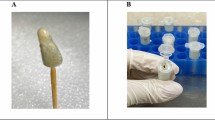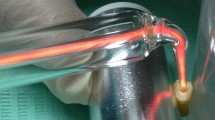Abstract
The aim of the study was to evaluate the photodynamic therapy (PDT) effect on root canals contaminated with Enterococcus faecalis using a light emitting diode (LED) light and a curcumin solution (CUR) as photosensitizer (PS). Eighty root canals from uniradicular human teeth were prepared with Protaper Universal rotary system and contaminated with E. faecalis for 21 days. They were divided as: GIa-PDT (CUR, pre-irradiation for 5 + 5 min of irradiation); GIb-PDT (CUR, pre-irradiation for 5 + 10 min of irradiation); GIIa-(CUR, pre-irradiation for 5 + 5 min without irradiation); GIIb-(CUR pre-irradiation for 5 + 10 min of irradiation); GIIIa-(physiological solution and irradiation for 5 min); and GIIIb-(physiological solution and irradiation for 10 min); positive and negative control groups. Collections from root canals were made at time intervals of 21 days after contamination, immediately after treatment, and 7 days after treatment, and submitted to colony forming units per milliter (CFU mL−1) counts. The data were submitted to ANOVA and Tukey multiple comparison tests, at a level of significance of 5 %. In the immediate post-treatment collection, group GIa showed greater bacterial reduction in comparison with GIIa, GIIb, GIIIa, GIIIb, and positive control (P < 0.05). At 7 days post-treatment, GIa showed significant bacterial reduction only in comparison with GIIIa (P < 0.05). Curcumin as sensitizer was effective by 5 min LED irradiation but not by 10 min irradiation PDT using LED light, and curcumin as PS was not effective in eliminating E. faecalis. No difference was observed for periods of irradiation.

Similar content being viewed by others
References
Aranda-Garcia AR, Guerreiro-Tanomaru JM, Faria-Júnior NB et al (2012) Antibacterial effectiveness of several irrigating solutions and the Endox Plus system—an ex vivo study. Int Endod J 45:1091–1096
Bahcall JK, Barss JT (2000) Understanding and evaluating the endodontic file. Gen Dent 48:690–692
Bergmans L, Moisiadis P, Huybrechts B et al (2008) Effect of photo-activated disinfection on endodontic pathogens ex vivo. Int Endod J 41:227–239
Bonsor SJ, Nichol R, Reid TM et al (2000) Microbiological evaluation of photo-activated disinfection in endodontics (an in vivo study). Br Dent J: 337–41
Bystrom A, Sundqvist G (1983) Bacteriologic evaluation of the effect of 0.5 % sodium hypochlorite in endodontic therapy. Oral Surg Oral Med Oral Pathol 55:307–312
Dahl TA, McGowan WM, Shand MA et al (1989) Photokilling of bacteria by the natural dye curcumin. Arch Microbiol 151:183–185
Dametto FR, Ferraz CCR, Gomes BPF et al (2005) In vitro assessment of the immediate and prolonged antimicrobial action of chlorhexidine gel as an endodontic irrigant against Enterococcus faecalis. Oral Surg Oral Med Oral Pathol Oral Rad Endod 99:768–772
de Gregorio C, Paranjpe A, Garcia A et al (2012) Efficacy of irrigation systems on penetration of sodium hypochlorite to working length and to simulated uninstrumented areas in oval shaped root canals. Int Endod J 45:475–481
de Oliveira BP, Aguiar CM, Câmara AC (2014) Photodynamic therapy in combating the causative microorganisms from endodontic infections. Eur J Dent 8:424–430
Delgado RJ, Gasparoto TH, Sipert CR et al (2010) Antimicrobial effects of calcium hydroxide and chlorhexidine on Enterococcus faecalis. J Endod 36:1389–1393
Demidova TN, Hamblin MR (2004) Photodynamic therapy targeted to pathogens. Int J Immunopathol Pharmacol 17:245–254
Dornelles-Morgental R, Guerreiro-Tanomaru JM, de Faria-Júnior NB et al (2011) Antibacterial efficacy of endodontic irrigating solutions and their combinations in root canals contaminated with Enterococcus faecalis. Oral Surg Oral Med Oral Pathol Oral Rad Endod 112:396–400
Dovigo LN, Pavarina AC, Ribeiro AP et al (2011) Investigation of the photodynamic effects of curcumin against Candida albicans. Photochem Photobiol 87:895–903
Dujic JS, Kippenberger A, Ramirez-Bosca J et al (2009) Curcumin in combination with visible light inhibits tumor growth in a xenograft tumor model. Int J Cancer 124:1422–1428
Eldeniz AU, Guneser MB, Akbulut MB (2013) Comparative antifungal efficacy of light-activated disinfection and octenidine hydrochloride with contemporary endodontic irrigants. Lasers Med Sci
Fimple JL, Fontana CR, Foschi F et al (2008) Photodynamic treatment of endodontic polymicrobial infection in vitro. J Endod 34:728–734
Fonseca MB, Junior PO, Pallota RC et al (2008) Photodynamic therapy for root canals infected with Enterococcus faecalis. Photomed Laser Surg 26:209–213
Foschi F, Fontana CR, Ruggiero K et al (2007) Photodynamic inactivation of Enterococcus faecalis in dental root canals in vitro. Lasers Surg Med 39:782–787
Franzen R, Gutknecht N, Falken S et al (2011) Bacterial effect of a Nd:YAG laser on Enterococcus faeccalis at pulse durations of 15 and 25 ms in dentine depths of 500 and 1,000 μm. Lasers Med Sci 1:95–101
Garcez AS, Fregnani ER, Rodriguez HM et al (2012) The use of optical fiber in endodontic photodynamic therapy. Is it really relevant? Lasers Med Sci 28:79–85
Garcez AS, Nunez SC, Hamblin MR et al (2008) Antimicrobial effects of photodynamic therapy on patients with necrotic pulps and periapical lesion. J Endod 34:138–142
Garcez AS, Nunez SC, Lage-Marques JL et al (2006) Efficiency of NaOCl and laser-assisted photosensitization on the reduction of Enterococcus faecalis in vitro. Oral Surg Oral Med Oral Pathol Oral Rad Endod 102:93–98
Garcez AS, Ribeiro MS, Tegos GP et al (2007) Antimicrobial photodynamic therapy combined with conventional endodontic treatment to eliminate root canal biofilm infection. Lasers Surg Med 39:59–66
Giusti JSM, Santos-Pinto LS, Pizzolito AC et al (2008) Antimicriobial photodynamic action on dentin using light-emitting diode light source. Photomed Laser Surg 26:281–287
Hamblin MR, Hasan T (2004) Photodynamic therapy: a new antimicrobial approach to infectious disease? Photochem Photobiol Sci 3:436–450
Haukvik T, Bruzell E, Kristensen S et al (2009) Photokilling of bacteria by curcumin in different aqueous preparations. Studies on curcumin and curcuminoids XXXVII. Phamazie 64:666–673
Hecker S, Hiller KA, Galler KM et al (2013) Establishment of an optimized ex vivo system for artificial root canal infection evaluated by use of sodium hypochlorite and the photodynamic therapy. Int Endod J 46:449–457
Hegge AB, Andersen T, Melvik JE et al (2011) Formulation and bacterial phototoxicity of curcumin loaded alginate foams for wound treatment applications: studies on curcumin and curcuminoides XLII. J Pharm Sci 100:174–185
Huang YY, Chen AC, Carroll JD, Hamblin MR (2009) Biphasic dose response in low level light therapy. Dose Response 7:358–383
Konopka K, Goslinski T (2007) Photodynamic therapy in dentistry. J Dental Res 86:694–707
Lima RK, Guerreiro-Tanomaru JM, Faria-Júnior NB et al (2012) Effectiveness of calcium hydroxide-based intracanal medicaments against Enterococcus faecalis. Int Endod J 45:311–316
Lima AK, Silva AR, Santos RR et al (2006) Cryopreservation of preantral ovarian follicles in situ from domestic cats (Felis catus) using different cryoprotective agents. Theriogenology 66:1664–1666
Meire MA, Coenye T, Nelis HJ et al (2012) In vitro inactivation of endodontic pathogens with Nd:YAG and Er: YAG lasers. Lasers Med Sci 4:695–701
Menezes MM, Valera MC, Jorge AOC et al (2005) In vitro evaluation of the effectiveness of irrigants and intracanal medicaments on microorganisms within root canals. Int Endod J 37:311–319
Miranda RG, Santos EB, Souto RM et al (2013) Ex vivo antimicrobial efficacy of the EndoVac system plus photodynamic therapy associated with calcium hydroxide against intracanal Enterococcus faecalis. Int Endod J 46:499–505
Mukerjee A, Sorensen TJ, Ranjan AP et al (2011) Spectroscopic properties of curcumin: orientation of transition moments. J Phys Chem B 114:12679–12684
Neelakantan P, Subbarao C, Sharma S et al (2013) Effectiveness of curcumin against Enterococcus faecalis biofilm. Acta Odontol Scand 71:1453–1457
Oliveira AC, Tanomaru JM, Faria-Junior N et al (2011) Bacterial leakage in root canals filled with conventional and MTA-based sealers. Int Endod J 44:370–375
Ozok AR, Persoon IF, Huse SM et al (2012) Ecology of the microbiome of the infected root canal system: a comparison between apical and coronal root segments. Int Endod J 45:530–541
Pirnat S, Lukac M, Ihan A (2011) Study of the direct bactericidal effect of Nd:YAG and diode laser parameters used in endodontics on pigmented and nonpigmented bacteria. Lasers Med Sci 6:755–761
Rios J, He J, Glickman GN, Spears R et al (2011) Evaluation of photodynamic therapy using a light-emitting diode lamp against Enterococcus faecalis in extracted human teeth. J Endod 37:856–859
Saunders JL, Eleazer PD, Zhang P et al (2004) Effect of a separated instrument on bacterial penetration of obturated root canals. J Endod 30:177–179
Sedgley C (2004) Root canal irrigation—a historical perspective. J Hist Dent 52:61–65
Shen L, Ji HF, Zhang HY (2005) A TD-DFT study on triplet excited-state properties of curcumin and its implications in elucidating the photosensitizing mechanisms of the pigment. Chem Phys Lett 409:300–303
Shipper G, Trope M (2004) In vitro microbial leakage of endodontically treated teeth using new and standard obturation techniques. J Endod 30:154–158
Silbert T, Bird PS, Milburn GJ et al (2000) Disinfection of root canals by laser dye photosensitization. J Dent Res 79:56–59
Siqueira JF, Rôças IN (2008) Clinical implications and microbiology of bacterial persistence after treatment procedures. J Endod 34:1291–1301
Siqueira-Junior JF, Magalhaes KM, Rocas IN (2007) Bacterial reduction in infected root canals treated with 2.5 % NaOCl as an irrigant and calcium hydroxide/camphorated paramonochlorophenol paste as an intracanal dressing. J Endod 33:667–672
Sjögren U, Figdor D, Persson S et al (1997) Influence of infection at the time of root filling on the outcome of endodontic treatment of teeth with apical periodontitis. Int Endod J 30:297–306
Soukos NS, Chen PS, Morris JT et al (2006) Photodynamic therapy for endodontic disinfection. J Endod 32:979–984
Souza LC, Brito PRR, Oliveira JCM et al (2010) Photodynamic therapy with two different photosensitizers as a supplement to instrumentation/irrigation procedures in promoting intracanal reduction of Enterococcus faecalis. J Endod 36:292–296
Stuart CH, Schwartz SA, Beeson TJ et al (2006) Enterococcus faecalis: its role in root canal treatment failure and current concepts in retreatment. J Endod 32:93–98
Upadya MH, Kishen A (2010) Influence of bacterial growth modes on the susceptibility to light-activated disinfection. Int Endod J 43:978–987
Wainwright M (1998) Photodynamic Antimicrobial Chemotherapy (PACT). J Antimicrob Chemother 42:13–28
Wang QQ, Zhang CF, Chu CH et al (2012) Prevalence of Enterococcus faecalis in saliva and filled root canals of teeth associated with apical periodontitis. Int J Oral Sci 4:19–23
Williams JA, Pearson GJ, Colles MJ (2006) Antibacterial action of Photoactivated Disinfection (PAD) used on endodontic bacteria in planktonic suspension and in artificial and human root canals. J Dent 34:363–371
Zhang C, Hou BX, Zhao HY et al (2012) Microbial diversity in failed endodontic root-filled teeth. Chin Med J 125:1163–1168
Author information
Authors and Affiliations
Corresponding author
Rights and permissions
About this article
Cite this article
da Frota, M.F., Guerreiro-Tanomaru, J.M., Tanomaru-Filho, M. et al. Photodynamic therapy in root canals contaminated with Enterococcus faecalis using curcumin as photosensitizer. Lasers Med Sci 30, 1867–1872 (2015). https://doi.org/10.1007/s10103-014-1696-z
Received:
Accepted:
Published:
Issue Date:
DOI: https://doi.org/10.1007/s10103-014-1696-z




